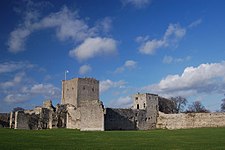Southampton Plot

The Southampton Plot was a conspiracy to depose King Henry V of England, revealed in 1415 just as the king was about to sail on campaign to France as part of the Hundred Years' War. The plan was to replace him with Edmund Mortimer, 5th Earl of March.
Overview
[edit]Edmund Mortimer, 5th Earl of March, was the great-grandson of Lionel of Antwerp, Duke of Clarence, second surviving son of King Edward III, and his claim to the throne was thus superior, should one allow female intermediaries (he was the grandson of Philippa of Clarence, daughter of Lionel), to that of Henry V and his father, Henry IV, who derived their claim from Henry IV's father, John of Gaunt, third surviving son of Edward III. Moreover, Edmund Mortimer's father, Roger Mortimer, 4th Earl of March, had been widely considered heir presumptive to King Richard II, who had no issue, and Edmund Mortimer himself had been heir presumptive to Richard II while a young child.[1]
The three ringleaders of the plot were Edmund Mortimer's brother-in-law, Richard of Conisburgh, 3rd Earl of Cambridge (also grandson of Edward III through his fourth surviving son, Edmund of Langley, and thus also Mortimer's first cousin twice removed); Henry Scrope, 3rd Baron Scrope of Masham (whose uncle Richard le Scrope had been executed for his part in a 1405 revolt); and Sir Thomas Grey, whose son, Thomas, had been betrothed in 1412 to Cambridge's only daughter, Isabel.[2]
The nominal principal, the Earl of March, informed King Henry of the plot on 31 July, stating that he had only just become aware of it. Richard, Scrope, and Grey were promptly arrested. The trial took place in Southampton; traditionally it is claimed that trial took place on the site now occupied by the Red Lion Inn, but there are no contemporary records of this. Grey was beheaded on 2 August and the two peers on 5 August, both in front of the Bargate.[3] Satisfied, Henry sailed for France on 11 August.
Scrope's involvement in the conspiracy surprised contemporaries, and continues to puzzle historians, as he was a royal favourite. Ian Mortimer claims Scrope had merely insinuated himself into the confidence of Cambridge and Grey to betray the conspiracy, just as Edward, Duke of York had done with the Epiphany Rising in 1400, but was forestalled by Mortimer's revelation of the conspiracy to the King on 31 July.[4] Pugh, however, finds Scrope's exculpatory statements at trial unconvincing, and states that Scrope never pretended that he had intended to inform the King of the conspiracy.[5] Pugh also contends that "there was no plot in 1415 to assassinate Henry V and his three brothers and that heinous charge, by far the most sensational in the indictment, was fabricated to ensure that Cambridge, Grey and Scrope did not escape the death penalty as a well-deserved punishment for the various other offences that they undoubtedly had committed".[6]
Aftermath
[edit]With the death of the Duke of York, the Earl of Cambridge's elder brother, at the Battle of Agincourt later that year, Cambridge's son Richard Plantagenet became heir to the title, which would eventually be returned to him after Henry V's death. Through his mother, he also inherited the Mortimer claim to the throne on the Earl of March's death; later in life Richard would use this claim to try to dethrone King Henry VI.
Dramatisation
[edit]The Southampton Plot is dramatised in Shakespeare's Henry V, in which it is portrayed as a French-financed betrayal of the king to stop Henry's invasion plans. It is also portrayed in the anonymous play, The History of Sir John Oldcastle (c.1600) and in William Kenrick's Falstaff's Wedding (1760).
The Southampton Plot is shown in The King (2019 film).
Footnotes
[edit]- ^ Cokayne 1932, p. 448; Richardson III 2011, pp. 193–6.
- ^ Richardson IV 2011, p. 401; Pugh 1988, p. 104.
- ^ Peberdy, Philip (1967). Bargate Guildhall Museum Southampton. Southampton Museums. p. 17. OCLC 655570724.
- ^ Mortimer, Ian (2009). 1415: Henry V's Year of Glory. The Bodley Head. pp. 300–319.
- ^ Pugh 1988, p. 130.
- ^ Pugh 1988, p. xii.
References
[edit]- Cokayne, George Edward (1932). The Complete Peerage, edited by H.A. Doubleday. Vol. VIII. London: St. Catherine Press. pp. 445–53.
- Davies, R.R. (2004). "Mortimer, Roger (VII), fourth earl of March and sixth earl of Ulster (1374–1398)". Oxford Dictionary of National Biography (online ed.). Oxford University Press. doi:10.1093/ref:odnb/19356. Retrieved 1 October 2012. (Subscription or UK public library membership required.)
- Pugh, T.B. (1988). Henry V and the Southampton Plot of 1415. Alan Sutton. ISBN 0-86299-541-8
- Richardson, Douglas (2011). Magna Carta Ancestry: A Study in Colonial and Medieval Families, ed. Kimball G. Everingham. Vol. II (2nd ed.). Salt Lake City.
{{cite book}}: CS1 maint: location missing publisher (link) ISBN 1449966381 - Richardson, Douglas (2011). Magna Carta Ancestry: A Study in Colonial and Medieval Families, ed. Kimball G. Everingham. Vol. III (2nd ed.). Salt Lake City.
{{cite book}}: CS1 maint: location missing publisher (link) ISBN 144996639X - Richardson, Douglas (2011). Magna Carta Ancestry: A Study in Colonial and Medieval Families, ed. Kimball G. Everingham. Vol. IV (2nd ed.). Salt Lake City.
{{cite book}}: CS1 maint: location missing publisher (link) ISBN 1460992709  Works related to Roger de Mortimer at Wikisource: Dictionary of National Biography, 1885–1900, Volume 39
Works related to Roger de Mortimer at Wikisource: Dictionary of National Biography, 1885–1900, Volume 39
Further reading
[edit]- Barker, Juliet (2006). Agincourt: The King, the Campaign, the Battle. United Kingdom: Abacus. ISBN 978-0-349-11918-2.
- Curry, Anne (2005). Agincourt: A New History. United Kingdom: Tempus Publishing. ISBN 978-0-7524-2828-4.
- Mortimer, Ian (2009). 1415: Henry V's Year of Glory. London: The Bodley Head. ISBN 978-0-224-07992-1.
